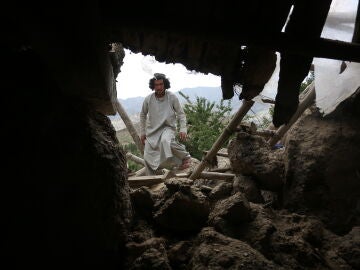
a chain of seven earthquakes up to 6.3 degrees This Saturday shook the province of Herat, in western Afghanistan, leaving at least 15 dead and 40 injured, although Afghan authorities fear that hundreds of people have died after the earthquakes.
The preliminary toll of victims has been communicated to the Reuters agency by a spokesperson for the Ministry of Disaster Management. In statements to the Efe agency, the same spokesperson indicated that “There is no town that does not have hundreds of deaths” and has warned that “the number of victims may increase even more”, while continuesearch operations.
Approximately a thousand people live in the affected villages, which have been reduced to rubble. “People are under collapsed houses and maybe it’s that many people [fallecida]”said the source cited by Efe.
For its part, Doctors Without Borders has reported that it is supporting the medical care of the Herat regional hospital, where they have arrived more than 300 injured, according to health authorities. “We have installed five medical tents to house up to 80 patients and we are supporting the emergency room with personnel and medical supplies,” the NGO reported on social networks.
At least seven earthquakes in a row
Afghanistan felt this Saturday at least seven tremors. The first of all, the largest, occurred at 12:11 local time, 14 kilometers deep and 33 kilometers from the city of Zindah Jan, according to the United States Geological Survey (USGS).
This first earthquake has been followed by four aftershocks in a period of one hour, 5.5; 4.7; 6.3; and 5.9 degrees, respectively. The fourth earthquake, also measuring 6.3, was recorded at a depth of about 10 kilometers and about 29 kilometers from Zindah Jan. Later, the US seismology service felt two more tremors almost an hour later in the Herat province of 4 .8 and 4.9 degrees.
Afghanistan is one of the most disaster-prone countries natural as it is located in the Hindu Kush mountain range, a point of great seismic activity and a common source of telluric movements in the region. The country also has a very vulnerable populationmostly poor, in addition to lacking sufficient infrastructure to deal with catastrophes.
At the end of June last year, a similar 5.9 magnitude earthquake in the eastern Afghan provinces of Paktika and Khost, bordering Pakistan, caused the death of more than a thousand people and left some 1,500 injured, in addition to destroying hundreds of homes.
Afghanistan suffered one of its biggest earthquake disasters in 1998, when two earthquakes of magnitude 5.9 and 6 in February killed about 4,000 people. A few months later, at the end of May, another magnitude 7 earthquake hit the area again and caused around 5,000 deaths.
Source: Lasexta
Ricardo is a renowned author and journalist, known for his exceptional writing on top-news stories. He currently works as a writer at the 247 News Agency, where he is known for his ability to deliver breaking news and insightful analysis on the most pressing issues of the day.











